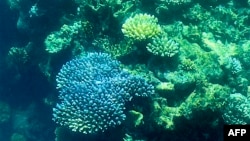One of the world’s largest marine citizen science projects starts Wednesday (October 12) on Australia’s Great Barrier Reef. It is the third year that a flotilla of tourism vessels, dive boats, tugboats, super yachts and recreational vessels will document the impact of climate change, including coral bleaching caused by warmer sea temperatures and other threats to the 2,300 kilometers coral system. Phil Mercer reports from Sydney.
Forty-two thousand images from 315 individual reefs were collected during the last Great Reef Census. They are analyzed by legions of international volunteers, or citizen scientists, who are helping to chart the health of the world’s largest coral system off northeastern Australia.
Experts have said that some parts of the Great Barrier Reef are flourishing. Others, though, are under siege from warmer ocean temperatures and more intense tropical storms as well as coral-eating crown-of-thorns starfish.
Warmer seas cause bleaching, forcing the coral to expel microscopic symbiotic algae that gives it most of its energy and color.
Reefs can recover from bleaching, but it can take years. If water temperatures do not return to normal, the coral can die.
There have been several mass bleaching events in recent years.
Andy Ridley is the chief executive officer of Citizens of the Great Barrier Reef, which organizes the annual survey.
He told VOA that the reef census hopes to show the overall health of the coral system.
“There is no doubt that the effects of climate [change] — whether it be through the bleaching but also through bigger storms, bigger cyclones — is very noticeable. There have been reports this year that there is, you know, significant coral growths across the system and what will be interesting to find out is whether or not that is still as diverse as it used to be, and that is the kind of thing that maybe the reconnaissance imagery will show,” he said.
The surveillance project on the Great Barrier Reef has become so big that artificial intelligence is being used to scan much of the data.
The coral system is a key marine biodiversity hotspot, and supplies food and income through tourism to millions of people.
The United Nations is assessing the impact of global warming on the Great Barrier Reef, as well as localized threats, including pollution and over-fishing.
Australia’s Great Barrier Reef spans 2,300 kilometers, an area about the size of Japan.
The Great Reef Census is a collaboration between Australian universities, charities, environmental organizations and the government.






